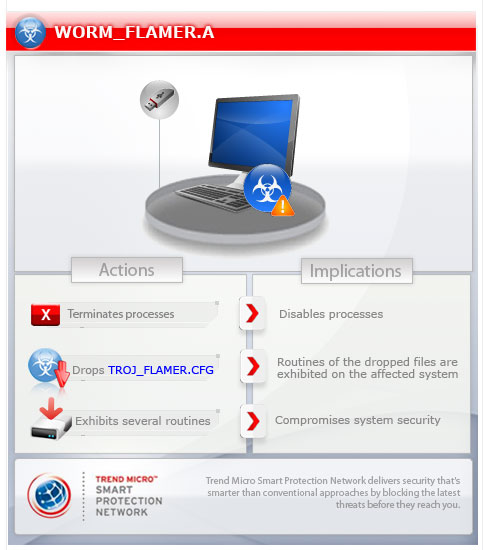WORM_FLAMER.A
W32.Flamer (Symantec); Worm.Win32.Flame.a (Kaspersky)
Windows 2000, Windows XP, Windows Server 2003


Threat Type: Worm
Destructiveness: No
Encrypted: Yes
In the wild: Yes
OVERVIEW
Propagates via removable drives
This info-stealing malware is dubbed as Flame malware and has been spotted in Iran and other countries since 2010. It is a multi-component threat which makes it hard to analyze.
To get a one-glance comprehensive view of the behavior of this Worm, refer to the Threat Diagram shown below.

This worm is capable of propagating in a local network when an infected machine is found in the said network. It also spreads through removable drives.
It may disable antivirus software by uninstalling registry keys. It is also capable of capturing screenshots, recording audio via the system's microphone, and manipulating a database that may contain records related to the malware’s malicious routines.
This worm arrives by connecting affected removable drives to a system or through an infected machine in the network.
This worm arrives by connecting affected removable drives to a system.
TECHNICAL DETAILS
Varies
PE
Yes
28 May 2012
Terminates processes, Compromises system security, Drops files
Arrival Details
This worm arrives by connecting affected removable drives to a system.
Installation
This worm drops the following copies of itself into the affected system:
- %System%\mssecmgr.ocx
(Note: %System% is the Windows system folder, which is usually C:\Windows\System on Windows 98 and ME, C:\WINNT\System32 on Windows NT and 2000, or C:\Windows\System32 on Windows XP and Server 2003.)
It drops the following files:
- %System%\boot32drv.sys - detected as TROJ_FLAMER.CFG
- %System%\ccalc32.sys - detected as TROJ_FLAMER.CFG
- %System%\advnetcfg.ocx - also detected as WORM_FLAMER.A
- %System%\msglu32.ocx - also detected as WORM_FLAMER.A
- %System%\nteps32.ocx - also detected as WORM_FLAMER.A
- %Program Files%\Common Files\Microsoft Shared\MSSecurityMgr\dstrlog.dat
- %Program Files%\Common Files\Microsoft Shared\MSSecurityMgr\lmcache.dat
- %Program Files%\Common Files\Microsoft Shared\MSSecurityMgr\mscrypt.dat
- %Program Files%\Common Files\Microsoft Shared\MSSecurityMgr\ntcache.dat
- %Program Files%\Common Files\Microsoft Shared\MSSecurityMgr\rccache.dat
- %Program Files%\Common Files\Microsoft Shared\MSSecurityMgr\ssitable
- %Windows%\Ef_trace.log
It creates the following folders:
- %Program Files%\Common Files\Microsoft Shared\MSSecurityMgr
(Note: %Program Files% is the default Program Files folder, usually C:\Program Files.)
Autostart Technique
This worm modifies the following registry entry(ies) to enable its automatic execution at every system startup:
HKEY_LOCAL_MACHINE\SYSTEM\CurrentControlSet\
Control\Lsa Authentication
Packages = "{default entry + mssecmgr.ocx}"
(Note: The default value data of the said registry entry is {default entry}.)
Process Termination
This worm terminates the following processes if found running in the affected system's memory:
- acs.exe
- AdoronsFirewall.exe
- almon.exe
- alsvc.exe
- alupdate.exe
- AntiHook.exe
- app_firewall.exe
- asr.exe
- aupdrun.exe
- authfw.exe
- avgnt.exe
- avguard.exe
- avp.exe
- avpm.exe
- bdagent.exe
- bdmcon.exe
- bdss.exe
- blackd.exe
- blackice.exe
- BootSafe.exe
- cdas17.exe
- cdinstx.exe
- clamd.exe
- cmdagent.exe
- configmgr.exe
- cpf.exe
- DCSUserProt.exe
- DF5SERV.exe
- DF5ServerService.exe
- DFAdmin6.exe
- DFServEx.exe
- dfw.exe
- dvpapi.exe
- EMLPROUI.exe
- EMLPROXY.exe
- FAMEH32.exe
- FCH32.exe
- Firewall 2004.exe
- FirewallGUI.exe
- FrzState.exe
- frzstate2k.exe
- fsaua.exe
- fsav32.exe
- Fsbwsys.exe
- fsdfwd.exe
- fsgk32.exe
- fsgk32st.exe
- fsguidll.exe
- Fsguiexe.exe
- FSM32.exe
- FSMA32.exe
- FSMB32.exe
- fspc.exe
- Fspex.exe
- fsqh.exe
- fsrt.exe
- Fssm32.exe
- FWService.exe
- fwsrv.exe
- fxsrv.exe
- gateway.exe
- ICMON.exe
- ike.exe
- ipatrol.exe
- ipcsvc.exe
- ipcTray.exe
- jpf.exe
- jpfsrv.exe
- kav.exe
- kavmm.exe
- Kpf4gui.exe
- Kpf4ss.exe
- live help.exe
- livesrv.exe
- lpfw.exe
- MPF.exe
- mpfcm.exe
- mpsvc.exe
- Netguard Lite.exe
- NetMon.exe
- NJEEVES.exe
- nstzerospywarelite.exe
- nvcoas.exe
- NVCSCHED.exe
- Nvoy.exe
- OEInject.exe
- omnitray.exe
- ONLINENT.exe
- ONLNSVC.exe
- op_mon.exe
- outpost.exe
- pcipprev.exe
- PF6.exe
- pfsvc.exe
- pgaccount.exe
- procguard.exe
- protect.exe
- PXAgent.exe
- PXConsole.exe
- R-Firewall.exe
- RDTask.exe
- RTT_CRC_Service.exe
- sab_wab.exe
- safensec.exe
- savadminservice.exe
- SavService.exe
- SCANWSCS.exe
- sched.exe
- SfCtlCom.exe
- smc.exe
- snsmcon.exe
- snsupd.exe
- sp_rsser.exe
- spfirewallsvc.exe
- sppfw.exe
- SpyHunter3.exe
- SpywareTerminator.exe
- SpywareTerminatorShield.exe
- SSUpdate.exe
- SUPERAntiSpyware.exe
- SWNETSUP.exe
- swupdate.exe
- sww.exe
- tikl.exe
- tinykl.exe
- TMAS_OEMon.exe
- TMBMSRV.exe
- TmPfw.exe
- TmProxy.exe
- Tray.exe
- TSAnSrf.exe
- TSAtiSy.exe
- TScutyNT.exe
- TSmpNT.exe
- UfSeAgnt.exe
- UmxAgent.exe
- UmxCfg.exe
- UmxFwHlp.exe
- Umxlu.exe
- UmxPol.exe
- UmxTray.exe
- updclient.exe
- VCATCH.exe
- vdtask.exe
- VSDesktop.exe
- vsmon.exe
- vsserv.exe
- WSWEEPNT.exe
- wwasher.exe
- xauth_service.exe
- xcommsvr.exe
- xfilter.exe
- Zanda.exe
- zerospyware le.exe
- ZeroSpyware Lite.exe
- zerospyware lite_installer.exe
- zlclient.exe
NOTES:
This worm propagates via removable drives. It also propagates to other systems through an infected machine in a local network.
It may disable antivirus software by uninstalling the following registry keys:
HKEY_LOCAL_MACHINE\SOFTWARE\KasperskyLab\AVP6
HKEY_LOCAL_MACHINE\SOFTWARE\KasperskyLab\protected\AVP7
SOFTWARE\KasperskyLab\avp6\settings
SOFTWARE\Symantec\InstalledApps
SOFTWARE\Symantec\Norton AntiVirus
SOFTWARE\Symantec\SymSetup\Internet security
SOFTWARE\Symantec\Symantec AntiVirus
This worm is capable of exhibiting the following routines:
- Capture screenshots
- Capture audio from microphone
- Log and report malware-related events
- Manipulate database
SOLUTION
9.200
9.148.03
28 May 2012
9.149.00
29 May 2012
Step 1
For Windows XP and Windows Server 2003 users, before doing any scans, please make sure you disable System Restore to allow full scanning of your computer.
Step 3
Restart in Safe Mode
Step 4
Search and delete this folder
- %Program Files%\Common Files\Microsoft Shared\MSSecurityMgr
Step 5
Search and delete this file
- %Windows%\Ef_trace.log
Step 6
Restore this modified registry value
Important: Editing the Windows Registry incorrectly can lead to irreversible system malfunction. Please do this step only if you know how or you can ask assistance from your system administrator. Else, check this Microsoft article first before modifying your computer's registry.
- In HKEY_LOCAL_MACHINE\SYSTEM\CurrentControlSet\Control\Lsa Authentication
- From: Packages = "{default entry + mssecmgr.ocx}"
To: Packages = "{default entry}"
- From: Packages = "{default entry + mssecmgr.ocx}"
Step 7
Restart in normal mode and scan your computer with your Trend Micro product for files detected as WORM_FLAMER.A. If the detected files have already been cleaned, deleted, or quarantined by your Trend Micro product, no further step is required. You may opt to simply delete the quarantined files. Please check this Knowledge Base page for more information.
Did this description help? Tell us how we did.

